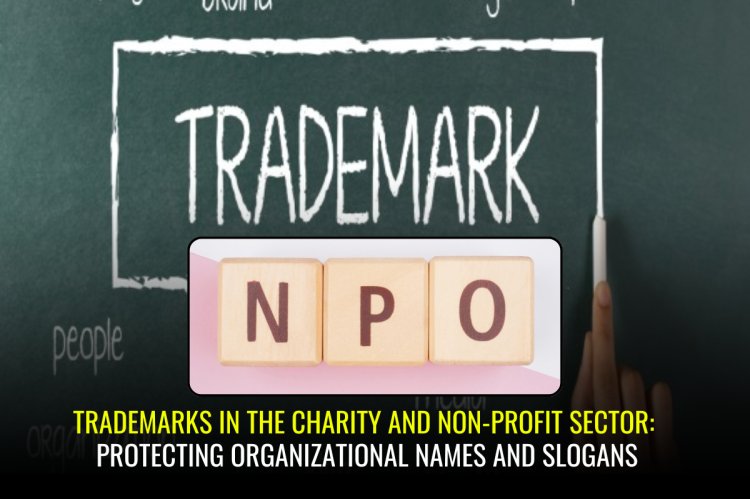Trademarks in the Charity and Non-Profit Sector: Protecting Organizational Names and Slogans
Trademarks play a crucial role in the charity and non-profit sector by safeguarding an organization's name, slogan, and brand identity. This blog explores the importance of trademark protection for non-profits, the types of elements that can be trademarked, notable case studies, and the challenges involved in securing a trademark. By registering trademarks, charities can enhance brand recognition, protect public trust, and prevent unauthorized use, ensuring their mission and fundraising efforts remain secure.

Introduction
In the charity and non-profit sector, establishing a unique identity is crucial for gaining public trust, securing donations, and fulfilling an organization’s mission. One effective way to safeguard an organization's identity is through trademark protection. Trademarks help prevent confusion among donors and beneficiaries while preserving the integrity of an organization’s brand. This blog explores the significance of trademarks for non-profits, what can be trademarked, notable case studies, and the challenges involved in the process.
1. Importance of Trademarks for Non-Profits
Unlike commercial enterprises, non-profits and charities may not always prioritize intellectual property protection. However, securing a trademark for a charity’s name, slogan, or logo provides numerous benefits:
- Brand Recognition: A trademarked name or slogan ensures the organization stands out in a crowded philanthropic space.
- Legal Protection: Trademark registration grants exclusive rights to use the mark, preventing unauthorized use by others.
- Public Trust and Credibility: Protecting a name or slogan reinforces legitimacy and authenticity, deterring fraudulent activities.
- Fundraising and Marketing: A distinct brand identity enhances fundraising efforts and marketing campaigns.
- Prevention of Confusion: Ensuring the name or slogan is unique prevents potential confusion with other organizations that may have similar missions.
2. What Can Be Trademarked?
Non-profits can seek trademark protection for various aspects of their brand, including:
- Organizational Name: The official name of the charity or non-profit.
- Slogans and Taglines: Phrases that define and promote the organization's mission.
- Logos and Symbols: Distinctive graphic elements associated with the organization.
- Names of Programs or Events: Signature initiatives that require protection to maintain their identity.
3. Notable Trademarked Non-Profit Organizations
Case Study 1: Missionaries of Charity
The Missionaries of Charity, founded by Mother Teresa, have taken legal steps to protect their name, logo, and associated symbols like blue and white stripes through trademark registration. This ensures their identity remains safeguarded from unauthorized use or commercial exploitation. The organization has actively opposed any misuse of its name to prevent public confusion and maintain the integrity of its mission. Given its global presence, the Missionaries of Charity have also sought trademark protection in multiple countries to secure their brand and ensure that donations and goodwill are directed toward their authentic charitable initiatives.
Case Study 2: Mayo Foundation for Medical Education and Research
The Delhi High Court granted interim relief to the Mayo Foundation for Medical Education and Research, a subsidiary of the US-based Mayo Clinic, by restraining Bodhisatva Charitable Trust from using the trademark “Mayo” or any deceptively similar name, such as “Mayo Institute.” The court's decision aimed to prevent public confusion and unauthorized use of the well-known brand associated with medical education and research. This ruling highlights the importance of trademark protection for non-profits, reinforcing that even charitable organizations must safeguard their brand identity against misuse, particularly in international jurisdictions.
To know more about this you can follow the li nk below:
<iframe width="560" height="315" src="https://www.youtube.com/embed/GrV8wvDOrVk?si=ywEkKgbC9cLg54Mn" title="YouTube video player" frameborder="0" allow="accelerometer; autoplay; clipboard-write; encrypted-media; gyroscope; picture-in-picture; web-share" referrerpolicy="strict-origin-when-cross-origin" allowfullscreen></iframe>
4. Can a Non-Profit Use Its Trademark for Revenue-Generating Activities?
From a trademark law perspective, a non-profit can use its trademark on any type of goods or services. Trademark laws do not distinguish between goods or services provided for revenue generation or not. However, a non-profit should check its organizational documents and the requirements of its tax-exempt status to determine whether such revenue-generating purposes are permitted. Many non-profits generate revenue through the sale of branded merchandise or licensing their trademarks while ensuring compliance with tax regulations.
5. Challenges and Considerations in Trademarking for Non-Profits
- Cost Barriers: Trademark registration involves fees, which can be a significant burden for smaller non-profits.
- International Protection Issues: Non-profits operating across multiple countries must navigate complex international trademark laws.
- Opposition and Legal Disputes: Other organizations may challenge a trademark application if they believe it infringes on an existing brand, leading to costly legal battles.
- Ongoing Compliance: Trademark holders must actively use and renew their trademarks to maintain protection, ensuring continuous legal rights.
Conclusion
Trademarks play a vital role in the non-profit sector by ensuring that an organization’s name and message remain unique and protected. While the registration process may require an investment of time and resources, the long-term benefits in brand security, public trust, and operational integrity make trademark protection a worthwhile endeavor for any charity or non-profit organization. By proactively safeguarding their identity, non-profits can continue to focus on their mission without the risk of brand misappropriation or confusion.












